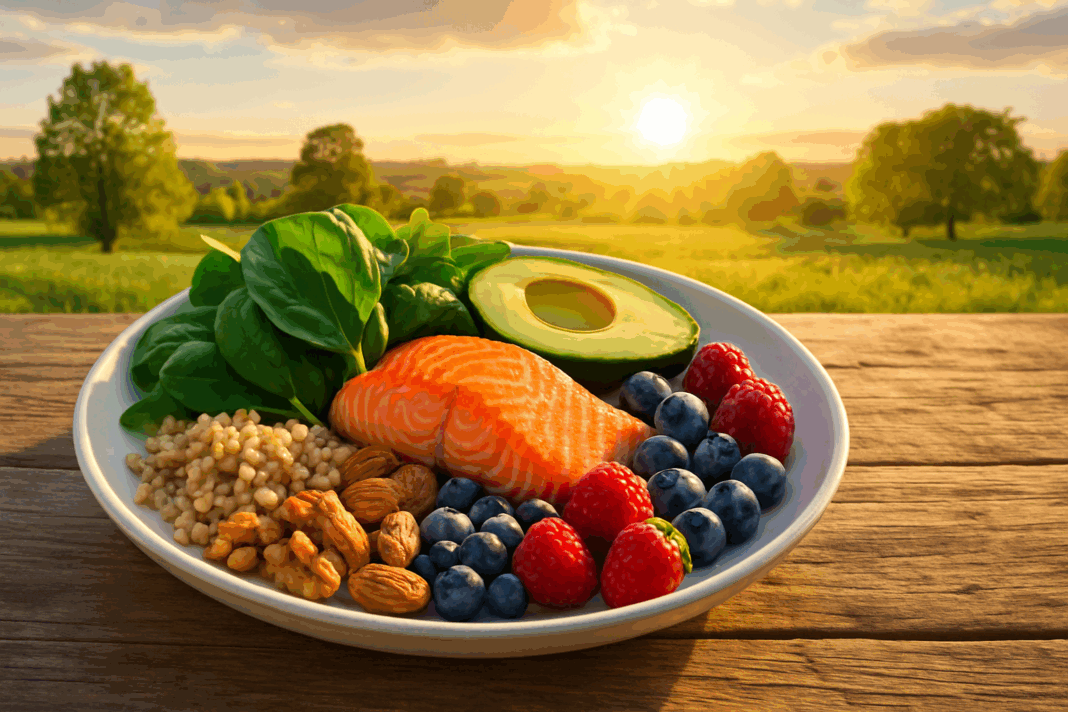In the ever-evolving landscape of nutritional science, few food groups have sparked as much interest among researchers and health-conscious consumers as nuts. These small, energy-dense morsels have long been cherished in culinary traditions across the globe, not only for their rich flavors and textures but also for their impressive nutritional profile. As awareness of preventative health grows, so does curiosity about the healthiest nuts to eat. Are nuts good for you? Which are the most nutritious nuts, and how can they support longevity, heart function, and protein intake? These are not just casual questions but meaningful inquiries into how dietary choices intersect with long-term wellness.
You may also like: 4 Ways to Have a Healthy Diet: Expert Tips Backed by Science for Better Nutrition and Long-Term Wellness
The growing body of scientific evidence surrounding nuts has helped solidify their position as some of the best food nuts for anyone seeking improved health outcomes. Once maligned due to their high fat content, nuts are now widely recognized for offering a blend of healthy fats, fiber, protein, and a wealth of bioactive compounds. With rising interest in plant-based diets, clean eating, and longevity science, understanding the health benefits of nuts is no longer niche—it is essential.
Nutritional Powerhouses: Why Nuts Deserve Their Superfood Status
Among all whole foods, nuts hold a uniquely concentrated balance of macronutrients and micronutrients. They contain significant amounts of unsaturated fats, particularly monounsaturated and polyunsaturated fats, which are key contributors to cardiovascular health. The presence of essential amino acids makes them an excellent plant-based protein source, especially in the context of vegan or vegetarian diets where animal proteins are limited.
Notably, the best nuts for protein also come packed with dietary fiber, contributing to improved satiety, blood sugar control, and digestive regularity. Fiber content in nuts is not merely a digestive aid—it also plays a role in reducing systemic inflammation and supporting gut microbiome diversity. So, when asking, “Do nuts contain fiber?” the answer is a resounding yes, and the implications for overall health are profound.
Micronutrient-wise, nuts offer a robust array of vitamins and minerals, including magnesium, selenium, vitamin E, and B vitamins. These compounds work synergistically to regulate oxidative stress, improve metabolic function, and enhance cellular resilience. This makes nuts not only healthy food nuts but also functional foods, offering preventive benefits beyond basic nutrition.

Debunking the Fat Myth: The Truth About Fats in Nuts
A longstanding concern in popular nutrition narratives has been the fat content of nuts. However, modern research has clearly shown that the types of fat present in nuts—primarily unsaturated fats—are among the most beneficial for human health. The relationship between nuts and seeds and unsaturated fat consumption is now well-established in both epidemiological and interventional studies.
The fats in nuts serve more than just an energy source; they are critical in supporting hormone production, cellular integrity, and anti-inflammatory pathways. More importantly, these fats do not equate to increased cardiovascular risk. In fact, the best nuts for heart health are precisely those that are high in monounsaturated and polyunsaturated fats, such as almonds, walnuts, and hazelnuts. These healthy fats help reduce LDL cholesterol, support HDL cholesterol, and reduce the risk of atherosclerosis.
Why Do Nuts Support Heart Health? The Science Explained
Cardiovascular disease remains the leading cause of death globally, but nutritional interventions like nut consumption offer promising avenues for prevention. A pivotal question—”Why do nuts support heart health?”—is answered through a range of mechanisms. First, nuts improve lipid profiles, which are closely tied to cardiovascular outcomes. Clinical trials have shown that including nuts in a balanced diet can lower total cholesterol and triglycerides.
Additionally, nuts are rich in arginine, an amino acid that serves as a precursor to nitric oxide, a molecule that dilates blood vessels and improves vascular function. Their high content of antioxidants, such as polyphenols and vitamin E, also helps neutralize oxidative damage to the endothelium. Together, these properties make nuts for heart healthy diets not only a recommendation but a necessity.

The Most Nutritious Nuts: Ranking the Best Options
When evaluating the best nuts to consume, it’s important to consider nutrient density rather than just calorie content. Almonds, for example, are often hailed as one of the most nutritious nuts due to their high vitamin E and magnesium content. Walnuts, rich in alpha-linolenic acid (ALA), a plant-based omega-3 fatty acid, stand out for their anti-inflammatory effects and brain-supportive benefits.
Pistachios offer an impressive combination of protein, fiber, and carotenoids like lutein and zeaxanthin, which are vital for eye health. Brazil nuts are uniquely high in selenium, a trace mineral essential for thyroid function and antioxidant defense. Meanwhile, hazelnuts contribute valuable B vitamins and copper, and cashews supply iron and zinc, supporting immune function and red blood cell production. Collectively, this nuts food list represents a diverse and highly beneficial category of whole foods.
Nuts and Healthy Eating Patterns: Beyond the Snack Bowl
Incorporating nuts into daily eating habits requires more than simply grabbing a handful between meals. One of the most beneficial aspects of nuts is their versatility. They can be added to breakfast bowls, salads, grain dishes, or used to create nutrient-dense spreads and plant-based dairy alternatives. In this way, nuts align perfectly with evidence-based dietary models like the Mediterranean diet and the DASH diet, both of which emphasize whole foods and unsaturated fat intake.
The role of nuts and healthy eating extends to blood sugar regulation as well. Because nuts are low in net carbohydrates and high in fat and protein, they slow the digestion of carbohydrates consumed alongside them. This makes them an excellent addition to meals for individuals managing insulin resistance, metabolic syndrome, or type 2 diabetes. Far from being a passive snack, nuts function as active agents of dietary improvement.

Protein Power: The Best Nuts for Protein Intake
While meat and dairy often dominate conversations around protein, many nuts offer meaningful contributions to daily protein needs. For those reducing or eliminating animal products, understanding the best nuts for protein becomes crucial. Peanuts—technically legumes but nutritionally categorized with nuts—provide around 7 grams of protein per ounce. Almonds follow closely with 6 grams, while pistachios and cashews offer 6 and 5 grams respectively.
The quality of protein in nuts is also worth noting. Although they do not contain all nine essential amino acids in optimal proportions like animal proteins, they can be paired with legumes and whole grains to create complete proteins. This strategy is especially effective in vegetarian and vegan diets, where plant-based complementary proteins must be thoughtfully combined.
Digestive Health and Fiber: Do Nuts Contain Fiber?
Fiber is often under-consumed in Western diets, despite its critical role in health. Nuts provide both soluble and insoluble fiber, each contributing uniquely to wellness. Soluble fiber feeds gut bacteria, promoting a diverse microbiome that influences immunity, mood, and metabolism. Insoluble fiber, meanwhile, adds bulk to stool and helps prevent constipation.
The fiber content in healthy nuts is significant enough to support daily needs. Almonds contain over 3 grams per ounce, and pistachios offer similar amounts. Not only do these fibers improve digestive function, but they also slow glucose absorption and increase satiety, helping with weight management. From a gastrointestinal health perspective, nuts are an underutilized but highly effective dietary tool.

Nutritional Bioavailability: How the Body Absorbs Nut Nutrients
Nutrient density is not the only factor in evaluating healthy food nuts. Bioavailability—the extent to which nutrients are absorbed and utilized by the body—also matters. Raw nuts may offer intact enzymes and heat-sensitive nutrients, while roasted nuts often provide better taste and digestibility. Soaking and sprouting nuts can improve mineral absorption by reducing antinutrients like phytic acid, which binds minerals and reduces their uptake.
This means that the way you prepare and consume nuts can impact their nutritional effectiveness. Choosing a variety of preparation methods ensures a broader spectrum of benefits. For example, soaking almonds before adding them to smoothies may enhance magnesium and calcium absorption, while roasted peanuts may offer more accessible antioxidants. This attention to detail transforms nuts from mere snacks to strategic components of nutrition plans.
Nuts for Longevity: Linking Nutrition to Lifespan
Longevity science increasingly points to inflammation, oxidative stress, and metabolic dysfunction as the central drivers of aging. Many of the most beneficial nuts to eat combat these very factors. Walnuts and almonds, rich in polyphenols and unsaturated fats, reduce inflammatory biomarkers. Brazil nuts, through their selenium content, modulate thyroid hormones and glutathione activity, both of which are linked to cellular longevity.
Observational studies have repeatedly shown that individuals who consume nuts regularly have lower all-cause mortality rates, especially from cardiovascular causes. While correlation does not imply causation, the consistent relationship between nut consumption and extended lifespan suggests a meaningful link. Including a mix of the best nuts for health in your daily routine may be one of the simplest, most accessible longevity strategies available.
Addressing Common Concerns: Are Nuts Bad for You?
Despite overwhelming evidence in favor of nut consumption, some people still question, “Are nuts bad for you?” This skepticism usually stems from concerns about calorie density, allergies, or anti-nutrients. While nuts are calorie-rich, they are also incredibly satiating, which can actually support weight management when consumed mindfully.
Nut allergies, especially to peanuts and tree nuts, are a serious issue for some individuals and should not be minimized. However, for the majority of the population, nuts are not only safe but deeply beneficial. Regarding antinutrients, it’s important to note that these compounds exist in many plant foods and are usually present in quantities too small to have harmful effects in the context of a varied diet.

Frequently Asked Questions: The Healthiest Nuts and Their Benefits
1. How can you personalize your nut intake based on your unique health goals?
While all healthy nuts offer general wellness benefits, tailoring your intake can amplify results depending on your individual health priorities. For example, those focusing on heart health might prioritize walnuts and almonds—recognized as some of the best nuts for heart health—due to their high content of unsaturated fats and anti-inflammatory compounds. Athletes or those building muscle may benefit from the best nuts for protein, such as peanuts and pistachios, which deliver higher protein per ounce. Individuals managing thyroid function might look toward selenium-rich Brazil nuts, which are often overlooked despite being one of the most beneficial nuts to eat for endocrine support. By selecting nuts with the most nutritional value that align with your physiological needs, you can optimize your diet beyond general recommendations.
2. Are there ways to make nuts easier to digest for people with sensitive stomachs?
Yes, for those who struggle with digestion, preparation methods like soaking and sprouting can reduce compounds that interfere with nutrient absorption. These techniques can break down phytic acid and enzyme inhibitors, making nuts more gut-friendly without sacrificing the health benefits of nuts. Light roasting is another strategy that may increase tolerability, although it may slightly reduce heat-sensitive nutrients. Choosing healthy food nuts that are easier on digestion—like macadamias or cashews—can also make a difference. These methods can help make nuts and healthy eating compatible even for those with mild digestive sensitivities.
3. How do nuts impact mental clarity and mood regulation?
Emerging research suggests that healthy nuts, particularly those rich in omega-3 fatty acids and magnesium, may influence neurotransmitter activity and inflammation in the brain. Walnuts, often among the best food nuts for cognition, have been linked to improved memory and focus. Cashews and almonds, rich in tryptophan and vitamin B6, can support serotonin synthesis, which may help regulate mood. These neurological benefits further underscore why nuts are good for you, particularly in stressful or cognitively demanding lifestyles. Including the most nutritious nuts in your diet may offer subtle yet significant mental health advantages beyond physical wellness.
4. What role do nuts play in hormone balance, especially for women?
Nuts beneficial for health extend their advantages into hormonal regulation, particularly in women. Almonds and walnuts, due to their unsaturated fat content, support estrogen metabolism and reproductive hormone balance. Brazil nuts, rich in selenium, play a vital role in thyroid health, which affects overall hormonal stability. Additionally, the fiber in these nuts—yes, nuts do contain fiber—helps modulate blood sugar levels, preventing insulin spikes that can disrupt hormonal cycles. Integrating the best nuts for health into daily meals may provide a gentle, food-based strategy for supporting female endocrine function over time.
5. Can children benefit from eating nuts regularly, and are there risks to consider?
For children without allergies, nuts are among the best food nuts to support growth, brain development, and immune resilience. Their protein, healthy fats, and mineral content make them powerful tools for childhood nutrition, especially during periods of rapid growth. However, whole nuts can be a choking hazard for toddlers, so age-appropriate forms like nut butters or finely chopped nuts should be used. Because some nuts like peanuts and tree nuts are allergenic, introducing them carefully and under pediatric guidance is essential. When introduced properly, healthy nuts can be a foundational component of a balanced childhood diet.
6. How do nuts influence skin health and appearance?
Nuts with most nutritional value often include compounds that support skin elasticity, hydration, and cellular repair. Vitamin E, found abundantly in almonds and hazelnuts, is a potent antioxidant that helps combat oxidative skin damage. Zinc in cashews and selenium in Brazil nuts contribute to wound healing and acne prevention, making these some of the best nuts to consume for skin wellness. The healthy fats in nuts also play a role in maintaining skin barrier integrity. Consistently eating the most beneficial nuts to eat can thus yield noticeable dermatological benefits over time.
7. Are some nuts more environmentally sustainable than others?
Sustainability varies across nut types, with certain varieties like almonds receiving criticism for their high water demands. However, environmental impact is not only about water use but also includes land efficiency, pesticide use, and carbon emissions. Pistachios and peanuts (technically legumes) tend to be more sustainable due to their nitrogen-fixing properties and lower water needs. Choosing the best nuts for health doesn’t have to come at an environmental cost if consumers stay informed. By opting for healthy food nuts that align with sustainability values, one can support both personal and planetary health.
8. How can nuts help manage energy levels throughout the day?
Due to their macronutrient balance, nuts offer slow-releasing energy that prevents blood sugar crashes and fatigue. This is particularly helpful for individuals with high cognitive or physical demands, making nuts a strategic choice for midday focus or workout recovery. Nuts and seeds unsaturated fats help fuel the brain, while fiber slows digestion and keeps you feeling full longer. When combined with fruit or whole grains, nuts become part of a synergistic meal or snack. This makes them not only good nuts to eat but strategic ones for sustained energy and productivity.
9. What are creative ways to incorporate nuts into everyday meals beyond snacking?
While snacking on a handful of almonds is a simple way to gain the health benefits of nuts, integrating them into main meals can amplify their impact. Crushed pistachios can be used as a crust for baked salmon, while cashew cream can replace dairy in pasta sauces or soups. Nut butters can be added to smoothies, oatmeal, or even savory sauces like satay. Using the best nuts for protein in meal-prep staples such as grain bowls or stuffed vegetables adds both texture and nutrition. These creative applications make nuts more than snacks—they become essential ingredients in a health-conscious kitchen.
10. What future innovations are emerging in nut-based nutrition and research?
Advancements in food technology and nutrition science are leading to novel ways to harness the health properties of nuts. Nut-derived oils, flours, and even probiotic-infused nut snacks are now available, expanding the reach of health food nuts beyond their raw form. Researchers are also exploring the role of nuts in gene expression, inflammation pathways, and microbiome health. With growing interest in personalized nutrition, we may soon see recommendations for the best nuts to eat based on genetic makeup or microbiome composition. These innovations reflect the evolving role of nuts as not just healthy, but precision-targeted superfoods that give someone nutrition in increasingly sophisticated ways.

Conclusion: Choosing the Best Nuts for a Healthy, Long Life
The question of what are the healthiest nuts to eat is not merely an academic one—it is central to developing dietary strategies that support long-term health, vitality, and disease prevention. The best nuts to consume are those that offer a synergistic combination of unsaturated fats, fiber, protein, and bioactive compounds. From the heart-protective properties of walnuts and almonds to the selenium-rich benefits of Brazil nuts, the health properties of nuts span an impressive range of biological systems.
Incorporating the most beneficial nuts to eat into your diet does not require radical change. A handful of almonds with breakfast, a spoonful of peanut butter as a snack, or a sprinkle of pistachios on a salad can collectively provide meaningful health gains. When viewed not as indulgences but as integral components of a nutrient-dense lifestyle, nuts emerge as some of the best nuts for heart health, metabolic wellness, and longevity.
Ultimately, whether you’re exploring the best nuts for protein, investigating which nuts contain fiber, or simply seeking good nuts to eat for overall vitality, this nutrient-rich food group offers a wealth of benefits. In a world increasingly focused on personalized nutrition and preventive medicine, few foods stand as universally valuable as health food nuts. By embracing them with knowledge and intentionality, we equip ourselves with one of nature’s most powerful tools for wellness and longevity.
Was this article helpful? Don’t let it stop with you. Share it right now with someone who needs to see it—whether it’s a friend, a colleague, or your whole network. And if staying ahead on this topic matters to you, subscribe to this publication for the most up-to-date information. You’ll get the latest insights delivered straight to you—no searching, no missing out.
Further Reading:
Nuts and your heart: Eating nuts for heart health


